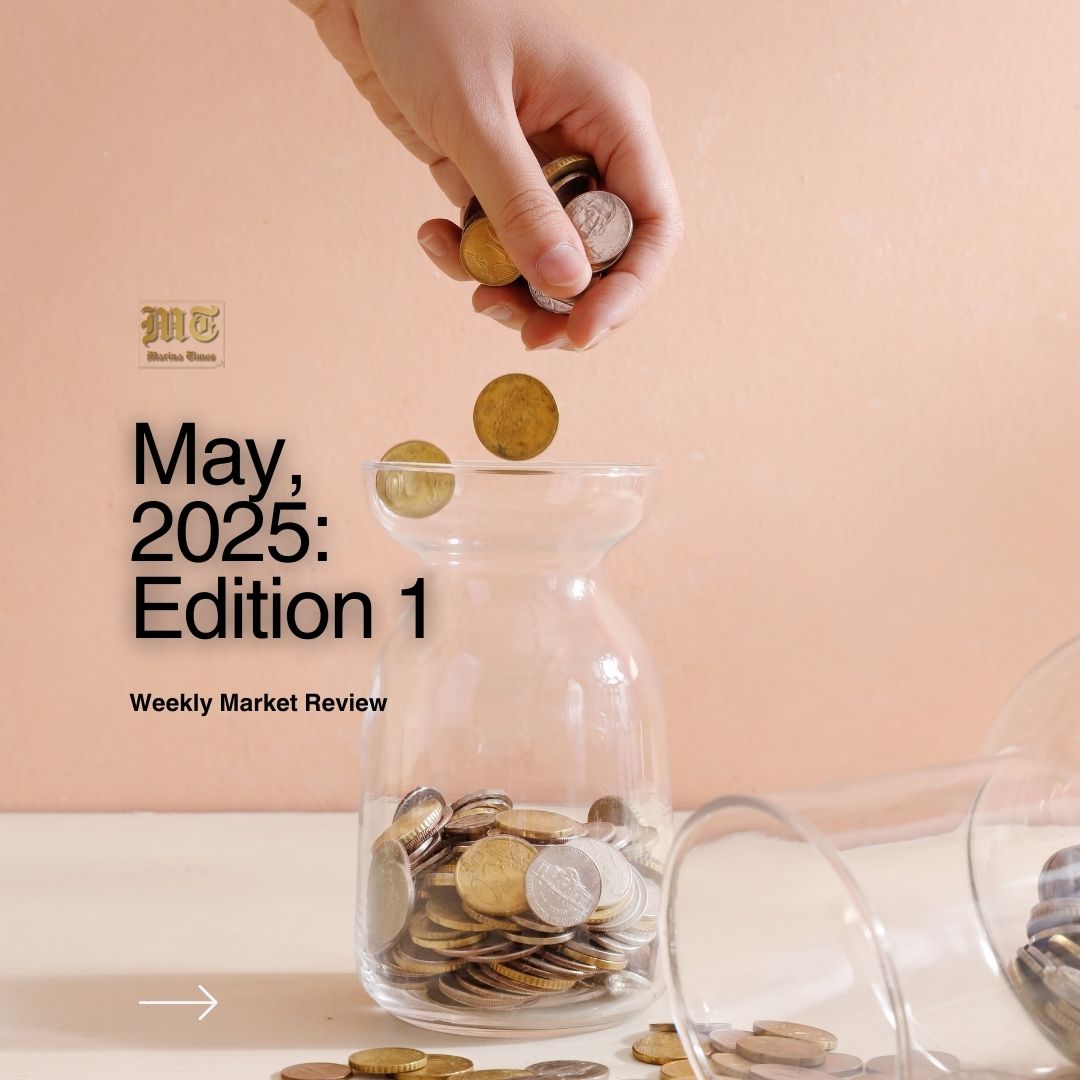

The recent trend in oil prices largely driven by OPEC accelerated output hikes is not a positive development for Nigeria given its oil-export dependence. It remains unclear, however, whether the downward trend will be sustained considering potential conflict escalations in Europe and in the Middle East.
The Debt Management Office (DMO) conducted the first FGN bond auction for the second quarter of 2025 last Monday, marking yet another episode in the country’s bid to raise domestic capital amidst persistent macroeconomic challenges. The auction saw a total allotment of ₦397.90 billion across two tenors: the 19.30% FGN APR 2029 and the 19.89% FGN MAY 2033 bonds.
In the week under review, system liquidity graduated and the money market opened with a liquidity surplus of over ₦1.248 trillion on Friday. In line with this, short-term borrowing rates saw a decrease, with the O/N rate falling to 26.83% from the previous week’s 26.85%, while the OPR was maintained at 26.50%. The Naira fluctuated between a high of $/₦1,606.50 on Friday and a low of $/₦1,580.00 on Wednesday, closing at $/₦1,606.00 on Friday.
Just as is often times the case at the end of the FGN bond auctions, the 2033 bond garnered excess demand, reflecting a clear preference for longer-dated instruments. In contrast, the 2029 bond met with little enthusiasm, suggesting a cautious stance among investors towards shorter durations despite the elevated returns.
The level of oversubscription on the 2033 bond was particularly striking. Against an offer size of ₦150 billion, bids surged past ₦452 billion, more than 300% of the amount on offer. The total amount allotted was ₦376.771 billion. On the flip side, the 2029 bond struggled to attract demand, drawing bids worth only ₦43.79 billion, less than 25% of the ₦200 billion on offer. The subdued interest led to a modest allotment of ₦21.13 billion. Following these developments, the 2029 bond has now closed 30 basis points below its original coupon level at 19.30%, while the 2033 bond closed 10 basis points higher than the coupon level of 19.89%, bringing the stop rates at the end of the auction to 19.00% and 19.99%, respectively.
These results are telling. The strong pull toward longer maturities may suggest that investors foresee potential monetary easing on the horizon, or at the very least, they remain drawn to instruments that offer insulation from policy volatility and inflationary risks. It also signals continued confidence in Nigeria’s sovereign creditworthiness, despite the complex fiscal environment. Notably, the FGN bond programme continues to serve as a reliable anchor for both institutional and retail investors seeking stability, safety, and yield in a market still routing inflation, currency volatility, and policy recalibration.
BONDS TENOR | APRIL 2029 | MAY 2033 |
AUCTION DATE | 28-04-2025 | 28-04-2025 |
SETTLEMENT DATE | 30-04-2025 | 30-04-2025 |
MATURITY DATE | 17-04-2029 | 15-05-2033 |
TENORS | 5-YEAR | 9-YEAR |
AMOUNT OFFERED (₦) | 200 BILLION | 150 BILLION |
SUBSCRIPTION (₦) | 43.791 BILLION | 452.161 BILLION |
AMOUNT ALLOTTED (₦) | 21.127 BILLION | 376.771 BILLION |
STOP RATES (%) | 19.0000 | 19.9900% |
PREVIOUS STOP RATES (%) | 19.0000 | 19.9900% |
In yet another affirmation of Nigeria’s liquidity-soaked financial environment, and following the FGN bond auction from the previous day, the Central Bank of Nigeria (CBN) successfully raised ₦804.85 billion at its Open Market Operations (OMO) auction held last Tuesday. With inflation remaining elevated and market participants hungry for high-yield instruments, investor demand once again surged, resulting in a total subscription of ₦1.057 trillion, an oversubscription by over 110%. Though impressive, this turnout marked a slight dip from the previous OMO sale on April 25, when the apex bank mopped up over ₦1 trillion.
The 350-day bill drew an overwhelming ₦923.60 billion in bids, nearly four times the offer. The CBN allotted ₦698.60 billion at a stop rate of 22.73%, maintaining the exact pricing seen in the previous auction. In contrast, the 329-day bill received a much cooler reception, attracting ₦133.25 billion, a little above half of its offer size. Only ₦106.25 billion was allotted at a stop rate of 22.69%. The muted interest in this shorter maturity confirms an ongoing trend: investors are clustering at the furthest end of the yield curve, opting for duration as a hedge against monetary uncertainty and inflation.
According to the CBN’s March 2025 Money and Credit Statistics, broad money supply (M3) rose by 3.2% month-on-month to ₦114.22 trillion, and by a steep 24% year-on-year. This liquidity excess has turned OMO bills — with their relatively high double-digit returns — into the preferred haven for institutional capital. This is because they offer stability in an otherwise unpredictable economic environment, both domestically and offshore.
The robust demand for longer-dated OMO instruments also reflects confidence in Nigeria’s sovereign paper despite macroeconomic uncertainties. Financial institutions, asset managers, and offshore funds are positioning for both yield and duration, betting that current rates may be near their peak and that locking in now could offer a hedge against future rate compression.
TENOR | AUCTION DATE | OFFER (₦’ B) | BIDS (₦’ B) | RANGE OF BIDS (%) | STOP RATES (%) | PREVIOUS STOP RATES (%) | TOTAL SALE (₦’ B) |
329-DAY | 29-04-2025 | 250.00 | 133.25 | 22.3200-22.8900 | 22.69 | 22.3700 | 106.25 |
350-DAY | 29-04-2025 | 250.00 | 923.60 | 22.4990-22.9700 | 22.3700 | 22.7300 | 698.60 |
In a significant policy shift aimed at deepening Nigeria’s participation in the African Continental Free Trade Area (AfCFTA) and adopting smoother cross-border commerce, the Central Bank of Nigeria (CBN) has authorised dealer banks to independently source foreign exchange for transactions settled through the Pan-African Payment and Settlement System (PAPSS) — without prior recourse to the apex bank.
This development was announced in a statement signed by Hakama Sidi Ali, Acting Director of Corporate Communications, and detailed in a circular dated April 28, 2025. The move reflects the CBN’s renewed strategy to liberalise FX access, enhance financial inclusion, and improve the operational efficiency of cross-border payments under the PAPSS framework.
PAPSS, launched in January 2022 by the Afreximbank, in partnership with the African Union and the AfCFTA Secretariat, serves as a centralised infrastructure for instant, secure, and cost-effective payments across African markets. Its architecture allows for transactions in local currencies, thus bypassing traditional reliance on third-party currencies such as the US Dollar or Euro. By significantly lowering transaction costs and speeding up settlements, PAPSS has the potential to become the financial backbone of intra-African trade, especially as AFCFTA implementation gains traction.
The CBN’s circular outlines several key reforms aimed at promoting broader adoption of PAPSS while safeguarding regulatory integrity:
Policy Area | New Directive | Impact |
FX Sourcing | Authorised dealer banks may source foreign exchange from the Nigerian Foreign Exchange Market (NFEM) to settle PAPSS transactions. | Enhances FX market liquidity and decentralises access, promoting faster execution. |
Documentation Thresholds | Simplified KYC/AML documentation allowed for: – Individuals: Transactions up to USD 2,000 equivalent in Naira – Corporates: Transactions up to USD 5,000 equivalent | Eases operational burden, encourages adoption among SMEs and individuals. |
Compliance Obligations | Applicants are responsible for ensuring all regulatory documents required by government agencies are in place. | Ensures goods clearance is not delayed due to incomplete documentation. |
Export Proceeds | Repatriated export proceeds via PAPSS must be certified by the processing bank. | Strengthens oversight and ensures traceability of FX inflows. |
The revised framework is tailored to balance convenience with compliance. By enabling smaller-value transactions to proceed with existing KYC and AML credentials held by banks, the CBN is effectively lowering the entry barrier for individuals and SMEs to participate in continental trade.
This policy pivot carries far-reaching implications. Primarily, the shift in FX sourcing responsibility to authorised banks is expected to deepen liquidity within the Nigerian Foreign Exchange Market, removing the CBN as an intermediary and allowing the market to operate more freely. This aligns with broader monetary reforms aimed at promoting FX market transparency and reducing systemic bottlenecks.
Furthermore, the simplification of documentation thresholds will accelerate the adoption of PAPSS, especially among micro and small enterprises that have historically been sidelined by the complexities of cross-border financial compliance. It also provides a nudge to financial institutions to strengthen internal onboarding and monitoring systems, as regulatory scrutiny will now rest more directly with them.
The recent activity in Nigeria’s financial markets points to a complex, but potentially pivotal transition. This suggests that the market continues to price in either a peak in interest rates or a moderate easing cycle, especially as inflationary pressures appear to be stabilsing, albeit at elevated levels, and with the next MPC meeting being held later this month.
Simultaneously, the Central Bank of Nigeria’s strategic liberalisation of the foreign exchange market, particularly the decentralisation of FX access under PAPSS, signals a shift towards market-oriented reforms. If implemented effectively, this could catalyse smoother intra-African trade, sustain investor confidence, and inject greater flexibility into Nigeria’s external accounts. However, execution risk remains, especially around compliance, given Nigeria’s historically fragile institutional frameworks. As Nigeria recalibrates its financial infrastructure and regulatory frameworks, the real challenge lies not in policy design, but in implementation fidelity. The next quarter will reveal whether these bold fiscal gestures translate into sustainable economic recovery or remain just another page in the policy playbook.
We expect oil prices to trade at new lows in the coming week albeit with sudden reversals as a consequence of likely conflict escalations. Cryptocurrency prices are likely to breach new highs amidst extreme volatility. Naira fixed income assets may trade in tandem with the regulatory narrative which in the interim seems to be geared towards managing borrowing costs by gradually lowering yields. If the plan to relist Nigeria on the JP Morgan Index for Emerging Markets comes to fruition, it will certainly tame yields further.